Crustal Structure of Northwestern Iran on the Basis of Regional Seismic Tomography Data
Abstract
1. Interpretation
2. Geological Features and Tectonic Setting of Northwestern Iran
3. Method and Data
4. Results and Tests
5. Discussion
6. Conclusions
- The obtained results correspond to the tectonic setting of the region, characterizing the Iranian plateau by high-velocity anomalies and the Zagros collision belt by a low-velocity anomaly. Main faults such as NTF, MZT and MRF are characterized by low-velocity anomalies.
- The volcanic zone of the Sabalan volcano is distinguished as a low-velocity anomaly from 10 km to a depth of more than 50 km, and the first 25–30 km beneath the Sahand volcano are characterized by a high velocity. We concluded that there is melted or/and hot magma beneath the young Sabalan volcano, and a solidified volcanic chamber present beneath the older Sahand.
- A low-velocity anomaly down to a depth of 10 km under the Zagros region characterizes a high thickness of the sediments.
- The NTF acts as a structural boundary between the low-velocity anomaly beneath Sahand and the high-velocity anomaly beneath Sabalan, focusing strain and deformation along its path. Its activity may have influenced the deformation and weakening of the crust in this area.
- The overall crustal structure observed in NW Iran has some similarities to the structure of different collision zones, such as Eastern Anatolia, Tien Shan and Pamir–Hindu Kush. The upper crust is characterized by high-velocity anomalies, while low-velocity ones are predominant in the lower crust. We propose the observed two-layered structure to be due to the delamination processes in the upper mantle.
Author Contributions
Funding
Data Availability Statement
Conflicts of Interest
References
- Copley, A.; Jackson, J. Active tectonics of the Turkish-Iranian plateau. Tectonics 2006, 25, TC6006. [Google Scholar] [CrossRef]
- Hessami, K.; Pantosti, D.; Tabassi, H.; Shabanian, E.; Abbassi, M.R.; Feghhi, K.; Solaymani, S. Paleoearthquakes and slip rates of the North Tabriz Fault, NW Iran: Preliminary results. Ann. Geophys. 2003, 46. [Google Scholar] [CrossRef]
- Moradi, A.S.; Hatzfeld, D.; Tatar, M. Microseismicity and seismotectonics of the North Tabriz fault (Iran). Tectonophysics 2011, 506, 22–30. [Google Scholar] [CrossRef]
- Djamour, Y.; Vernant, P.; Nankali, H.R.; Tavakoli, F. NW Iran-eastern Turkey present-day kinematics: Results from the Iranian permanent GPS network. J. Geophys. Res. Solid Earth 2011, 99, 19635–19646. [Google Scholar] [CrossRef]
- Rastbood, A.; Voosoghi, B. Extension and slip rate partitioning in NW Iran constrained by GPS measurements. J. Geod. Sci. 2011, 1, 286–304. [Google Scholar] [CrossRef]
- Berberian, M. Patterns of historical earthquake ruptures on the Iranian plateau. Dev. Earth Surf. Process. 2014, 17, 439–518. [Google Scholar] [CrossRef]
- Kheirkhah, M.; Allen, M.; Emami, M. Quaternary syncollision magmatism from the Iran/Turkey borderlands. J. Volcanol. Geotherm. Res. 2009, 182, 1–12. [Google Scholar] [CrossRef]
- Talebi, A.; Koulakov, I.; Moradi, A.; Rahimi, H.; Gerya, T. Ongoing formation of felsic lower crustal channel by relamination in Zagros collision zone revealed from regional tomography. Sci. Rep. 2020, 10, 8224. [Google Scholar] [CrossRef]
- Maggi, A.; Priestley, K. Surface waveform tomography of the Turkish–Iranian plateau. Geophys. J. Int. 2005, 160, 1068–1080. [Google Scholar] [CrossRef]
- Kaviani, A.; Paul, A.; Bourova, E.; Hatzfeld, D.; Pedersen, H.; Mokhtari, M. A strong seismic velocity contrast in the shallow mantle across the Zagros collision zone (Iran). Geophys. J. Int. 2007, 171, 399–410. [Google Scholar] [CrossRef]
- Shomali, Z.H.; Keshvari, F.; Hassanzadeh, J.; Mirzaei, N. Lithospheric structure beneath the Zagros collision zone resolved by non-linear teleseismic tomography. Geophys. J. Int. 2011, 187, 394–406. [Google Scholar] [CrossRef]
- Motaghi, K.; Shabanian, E.; Kalvandi, F. Underplating along the northern portion of the Zagros suture zone, Iran. Geophys. J. Int. 2017, 210, 375–389. [Google Scholar] [CrossRef]
- Hafkenscheid, E.; Wortel, M.J.R.; Spakman, W. Subduction history of the Tethyan region derived from seismic tomography and tectonic reconstructions. J. Geophys. Res. Solid Earth 2006, 111, B08401. [Google Scholar] [CrossRef]
- Mohammadi, E.; Sodoudi, F.; Kind, R.; Rezapour, M. Presence of a layered lithosphere beneath the Zagros collision zone. Tectonophysics 2013, 608, 366–375. [Google Scholar] [CrossRef]
- Wang, X.; Chen, L.; Talebian, M.; Ai, Y.; Jiang, M.; Yao, H.; He, Y.; Ghods, A.; Sobouti, F.; Wan, B.; et al. Shallow Crustal Response to Arabia-Eurasia Convergence in Northwestern Iran: Constraints From Multifrequency P-Wave Receiver Functions. J. Geophys. Res. Solid Earth 2022, 127, e2022JB024515. [Google Scholar] [CrossRef]
- Teknik, V.; Ghods, A.; Thybo, H.; Artemieva, I.M. Crustal density structure of the northwestern Iranian Plateau. Can. J. Earth Sci. 2019, 56, 1347–1365. [Google Scholar] [CrossRef]
- Shirzad, T.; VahidRavesh, S.; Mortezanejad, G.; Abdollahi, S.; Kakhki, M.K.; Naghavi, M.; Rahimi, H.; Hatami, M.R. The crustal and upper-mantle structure beneath NW Iran: An integrated analysis of surface waves and gravity data. Geophys. J. Int. 2024, 239, 982–999. [Google Scholar] [CrossRef]
- Alinaghi, A.; Koulakov, I.; Thybo, H. Seismic tomographic imaging of P-and S-waves velocity perturbations in the upper mantle beneath Iran. Geophys. J. Int. 2007, 169, 1089–1102. [Google Scholar] [CrossRef]
- Rezaeifar, M.; Kissling, E.; Shomali, Z.H.; Shahpasand-Zadeh, M. 3D crustal structure of the northwest Alborz region (Iran) from local earthquake tomography. Swiss J. Geosci. 2016, 109, 389–400. [Google Scholar] [CrossRef]
- Amiri, S.; Maggi, A.; Tatar, M.; Zigone, D.; Zaroli, C. Rayleigh wave group velocities in North-West Iran: SOLA Backus-Gilbert vs. Fast Marching tomographic methods. Seismica 2023, 2. [Google Scholar] [CrossRef]
- Arvin, S.; Sobouti, F.; Priestley, K.; Ghods, A.; Motaghi, K.; Tilmann, F.; Eken, T. Seismic anisotropy and mantle deformation in NW Iran inferred from splitting measurements of SK (K) S and direct S phases. Geophys. J. Int. 2021, 226, 1417–1431. [Google Scholar] [CrossRef]
- Mortezanejad, G.; Rahimi, H.; Romanelli, F.; Panza, G.F. Lateral variation of crust and upper mantle structures in NW Iran derived from surface wave analysis. J. Seismol. 2019, 23, 77–108. [Google Scholar] [CrossRef]
- Maheri-Peyrov, M.; Ghods, A.; Donner, S.; Akbarzadeh-Aghdam, M.; Sobouti, F.; Motaghi, K.; Hassanzadeh, M.; Mortezanejad, G.; Talebian, M.; Chen, L. Upper crustal structure of NW Iran revealed by regional 3-D Pg velocity tomography. Geophys. J. Int. 2020, 222, 1093–1108. [Google Scholar] [CrossRef]
- Rahimi, H.; Hamzehloo, H. Lapse time and frequency-dependent attenuation of coda waves in the Zagros continental collision zone in Southwestern Iran. J. Geophys. Eng. 2008, 5, 173–185. [Google Scholar] [CrossRef]
- Rahimi, H.; Hamzehloo, H.; Kamalian, N. Estimation of coda and shear wave attenuation in the volcanic area in SE Sabalan Mountain, NW Iran. Acta Geophys. 2010, 58, 244–268. [Google Scholar] [CrossRef]
- Gholamzadeh, A.; Rahimi, H.; Yaminifard, F. Spatial and temporal variation of coda-wave attenuation in the Faryab region, southeast of the Sanandaj–Sirjan zone, using aftershocks of the Tiab earthquake of 28 February 2006. Bull. Seismol. Soc. Am. 2014, 104, 529–539. [Google Scholar] [CrossRef]
- Irandoust, M.A.; Sobouti, F.; Rahimi, H. Lateral and depth variations of coda Q in the Zagros region of Iran. J. Seismol. 2015, 20, 197–211. [Google Scholar] [CrossRef]
- Amiri Fard, R.; Javan Doloei, G.; Rahimi, H.; Farrokhi, M. Attenuation of P and S waves in Western part of Iran. Geophys. J. Int. 2019, 218, 1143–1156. [Google Scholar] [CrossRef]
- Talebi, A.; Rahimi, H.; Moradi, A.; Mirzaei, M.; Koulakov, I. Qp, Qs, Qc, Qi, and Qsc Qsc Attenuation Parameters in the Zagros Region, Iran. Pure Appl. Geophys. 2022, 178, 4487–4505. [Google Scholar] [CrossRef]
- Talebi, A.; Rahimi, H.; Moradi, A. Coda wave attenuation in the Zagros collision zone in southwest of Iran and its tectonic implications. Acta Geophys. 2025, 73, 119–130. [Google Scholar] [CrossRef]
- Zarunizadeh, Z.; Motaghi, K.; Rahimi, H. Attenuation of High-Frequency Seismic Waves in NW Iran. Pure Appl. Geophys. 2024, 181, 1811–1829. [Google Scholar] [CrossRef]
- Naghavi, M.; Rahimi, H.; Moradi, A.; Mukhopadhyay, S. Spatial variations of seismic attenuation in the North West of Iranian plateau from analysis of coda waves. Tectonophysics 2017, 708, 70–80. [Google Scholar] [CrossRef]
- Richards, J.P.; Spell, T.; Rameh, E.; Razique, A.; Fletcher, T. High Sr/Y Magmas Reflect Arc Maturity, High Magmatic Water Content, and Porphyry Cu ± Mo ± Au Potential: Examples from the Tethyan arcs of Central and Eastern Iran and Western Pakistan. Econ. Geol. 2012, 107, 295–332. [Google Scholar] [CrossRef]
- Hessami, K.; Jamali, F.; Tabassi, H. Major Active Faults of Iran; International Institute of Earthquake Engineering and Seismology: Tehran, Iran, 2003. [Google Scholar]
- Vergés, J.; Saura, E.; Casciello, E.; Fernàndez, M.; Villaseñor, A.; Jiménez-Munt, I.; García Castellanos, D. Crustal-scale cross-sections across the NW Zagros belt: Implications for the Arabian margin reconstruction. Geol. Mag. 2011, 148, 739–761. [Google Scholar] [CrossRef]
- Alavi, M. Tectonics of the Zagros orogenic belt of Iran: New data and interpretations. Tectonophysics 1994, 229, 211–238. [Google Scholar] [CrossRef]
- Talebian, M.; Jackson, J. Offset on the Main Recent Fault of NW Iran and implications for the late Cenozoic tectonics of the Arabia–Eurasia collision zone. Geophys. J. Int. 2002, 150, 422–439. [Google Scholar] [CrossRef]
- Şengör, A.M.C. A new model for the late Palaeozoic—Mesozoic tectonic evolution of Iran and implications for Oman. Geol. Soc. Lond. Spec. Publ. 1990, 49, 797–831. [Google Scholar] [CrossRef]
- Ghods, A.; Shabanian, E.; Bergman, E.; Faridi, M.; Donner, S.; Mortezanejad, G.; Aziz-Zanjani, A. The Varzaghan-Ahar, Iran, earthquake doublet (M w 6.4, 6.2): Implications for the geodynamics of northwest Iran. Geophys. J. Int. 2015, 203, 522–540. [Google Scholar] [CrossRef]
- Berberian, M.; Qorashi, M.; Jackson, J.A.; Priestley, K.; Wallace, T. The Rudbar-Tarom earthquake of 20 June 1990 in NW Persia: Preliminary field and seismological observations, and its tectonic significance. Bull. Seismol. Soc. Am. 1992, 82, 1726–1755. [Google Scholar]
- Mangino, S.; Priestley, K. The crustal structure of the southern Caspian region. Geophys. J. Int. 1998, 133, 630–648. [Google Scholar] [CrossRef]
- Brunet, M.F.; Korotaev, M.V.; Ershov, A.V.; Nikishin, A.M. The South Caspian Basin: A review of its evolution from subsidence modelling. Sediment. Geol. 2003, 156, 119–148. [Google Scholar] [CrossRef]
- Allen, M.B.; Vincent, S.J.; Alsop, I.; Ismail-Zadeh, A.; Flecker, R. Late Cenozoic deformation in the South Caspian region: Effects of a rigid basement block within a collision zone. Tectonophysics 2003, 366, 223–239. [Google Scholar] [CrossRef]
- Aziz Zanjani, A.; Ghods, A.; Sobouti, F.; Bergman, E.; Mortezanejad, G.; Priestley, K.; Madanipour, S.; Rezaeian, M. Seismicity in the western coast of the South Caspian Basin and the Talesh Mountains. Geophys. J. Int. 2013, 195, 799–814. [Google Scholar] [CrossRef]
- Agard, P.; Omrani, J.; Jolivet, L.; Whitechurch, H.; Vrielynck, B.; Spakman, W.; Monie, P.; Meyer, B.; Wortel, R. Zagros orogeny: A subduction-dominated process. Geol. Mag. 2011, 148, 692–725. [Google Scholar] [CrossRef]
- Şengör, A.M.C.; Kidd, W.S.F. Post-collisional tectonics of the Turkish-Iranian plateau and a comparison with Tibet. Tectonophysics 1979, 55, 361–376. [Google Scholar] [CrossRef]
- Pang, K.N.; Chung, S.L.; Zarrinkoub, M.H.; Lin, Y.C.; Lee, H.Y.; Lo, C.H.; Khatib, M.M. Iranian ultrapotassic volcanism at~ 11 Ma signifies the initiation of post-collisional magmatism in the Arabia–Eurasia collision zone. Terra Nova 2013, 25, 405–413. [Google Scholar] [CrossRef]
- Koulakov, I. LOTOS code for local earthquake tomographic inversion: Benchmarks for testing tomographic algorithms. Bull. Seismol. Soc. Am. 2009, 99, 194–214. [Google Scholar] [CrossRef]
- Koulakov, I. Out-of-network events can be of great importance for improving results of local earthquake tomography. Bull. Seismol. Soc. Am. 2009, 99, 2556–2563. [Google Scholar] [CrossRef]
- Engdahl, E.R.; Jackson, J.A.; Myers, S.C.; Bergman, E.A.; Priestley, K. Relocation and assessment of seismicity in the Iran region. Geophys. J. Int. 2006, 167, 761–778. [Google Scholar] [CrossRef]
- Um, J.; Thurber, C. A fast algorithm for two-point seismic ray tracing. Bull. Seismol. Soc. Am. 1987, 77, 972–986. [Google Scholar] [CrossRef]
- Paige, C.C.; Saunders, M.A. LSQR: An algorithm for sparse linear equations and sparse least squares. ACM Trans. Math. Softw. 1982, 8, 43–71. [Google Scholar] [CrossRef]
- Albaric, J.; Deverchere, J.; Perrot, J.; Jakovlev, A.; Deschamps, A. Deep crustal earthquakes in North Tanzania, East Africa: Interplay between tectonic and magmatic processes in an incipient rift. Geochem. Geophys. Geosyst. 2014, 15, 374–394. [Google Scholar] [CrossRef]
- Bianchi, M.; Heit, B.; Jakovlev, A.; Yuan, X.; Kay, S.M.; Sandvol, E.; Alonso, R.N.; Coira, B.; Brown, L.; Kind, R.; et al. Teleseismic tomography of the southern Puna plateau in Argentina and adjacent regions. Tectonophysics 2013, 586, 65–83. [Google Scholar] [CrossRef]
- Foix, O.; Aiken, C.; Saurel, J.M.; Feuillet, N.; Jorry, S.J.; Rinnert, E.; Thinon, I. Offshore Mayotte volcanic plumbing revealed by local passive tomography. J. Volcanol. Geotherm. Res. 2021, 420, 107395. [Google Scholar] [CrossRef]
- Bernal-Olaya, R.; Mann, P.; Carlos, A. Vargas, Earthquake, tomographic, seismic reflection, and gravity evidence for a shallowly dipping subduction zone beneath the Caribbean Margin of Northwestern Colombia. In Petroleum Geology and Potential of the Colombian Caribbean Margin; Bartolini, C., Mann, P., Eds.; AAPG Memoir 108; AAPG: Shawnee, KS, USA, 2015; pp. 247–270. [Google Scholar]
- Popa, M.; Radulian, M.; Szakács, A.; Seghedi, I.; Zaharia, B. New seismic and tomography data in the southern part of the Harghita Mountains (Romania, Southeastern Carpathians): Connection with recent volcanic activity. Pure Appl. Geophys. 2012, 169, 1557–1573. [Google Scholar] [CrossRef]
- Koulakov, I. High-Frequency P and S Velocity Anomalies in the Upper Mantle beneath Asia from Inversion of Worldwide Traveltime Data. J. Geophys. Res. Solid Earth 2011, 116, B04301. [Google Scholar] [CrossRef]
- Lü, Y.; Chen, L. Upper crustal P-wave velocity structure beneath two volcanic areas in northern Iran. Sci. China Earth Sci. 2017, 60, 786–795. [Google Scholar] [CrossRef]
- Medved, I.; Polat, G.; Koulakov, I. Crustal Structure of the Eastern Anatolia Region (Turkey) Based on Seismic Tomography. Geosciences 2021, 11, 91. [Google Scholar] [CrossRef]
- Medved, I.; Bataleva, E.; Buslov, M. Studying the depth structure of the Kyrgyz Tien Shan by using the seismic tomography and magnetotelluric sounding methods. Geosciences 2021, 11, 122. [Google Scholar] [CrossRef]
- Aminov, J.; Koulakov, I.; Jakovlev, A.; Zhao, J.; El-Khrepy, S.; Aminov, J.; Al Arifi, N.; Aminov, J.; Mamadjanov, Y. Directions of lithosphere interactions in the Pamir–Hindu Kush junction inferred from anisotropic tomography. Can. J. Earth Sci. 2020, 57, 601–616. [Google Scholar] [CrossRef]


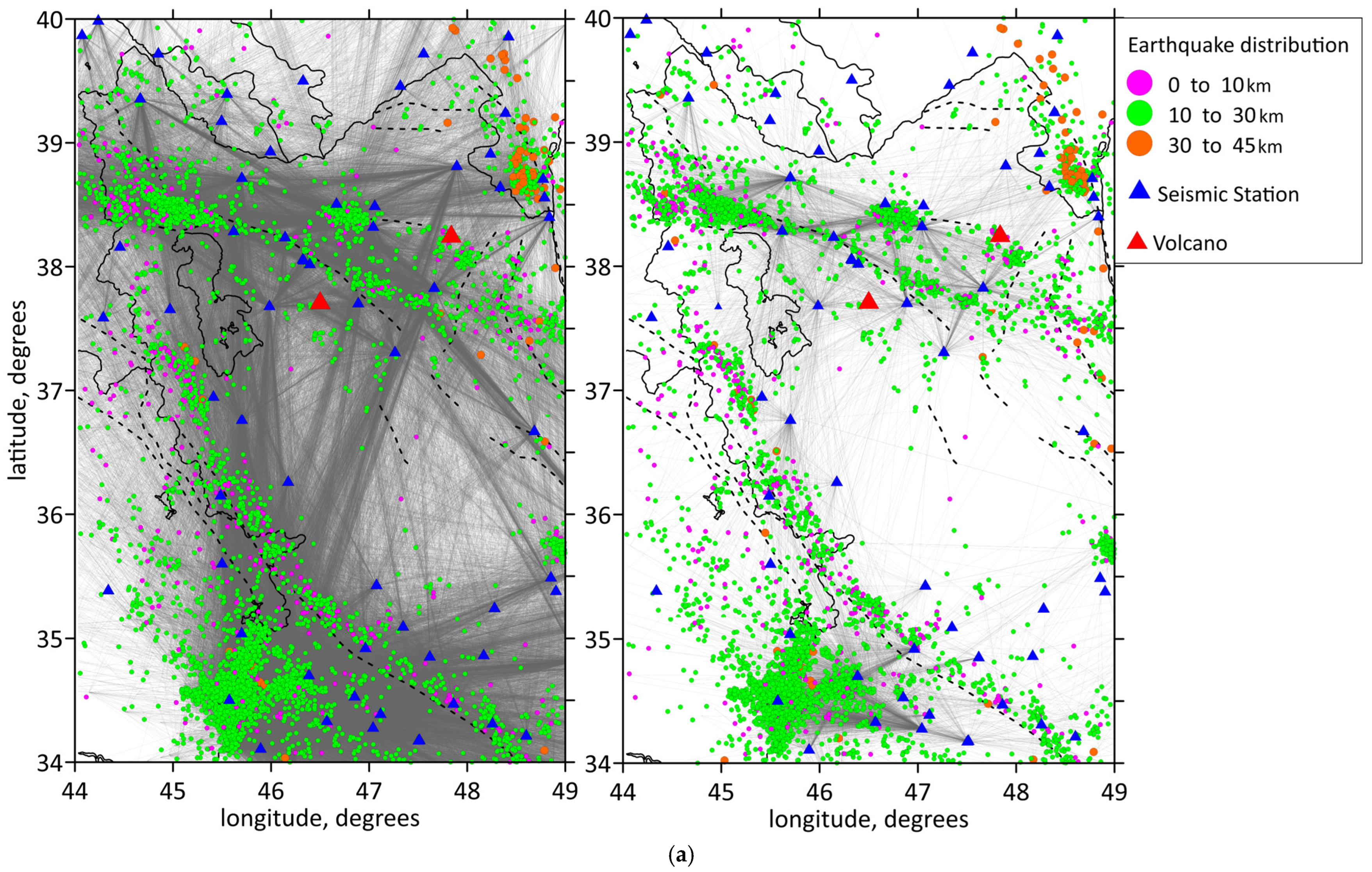
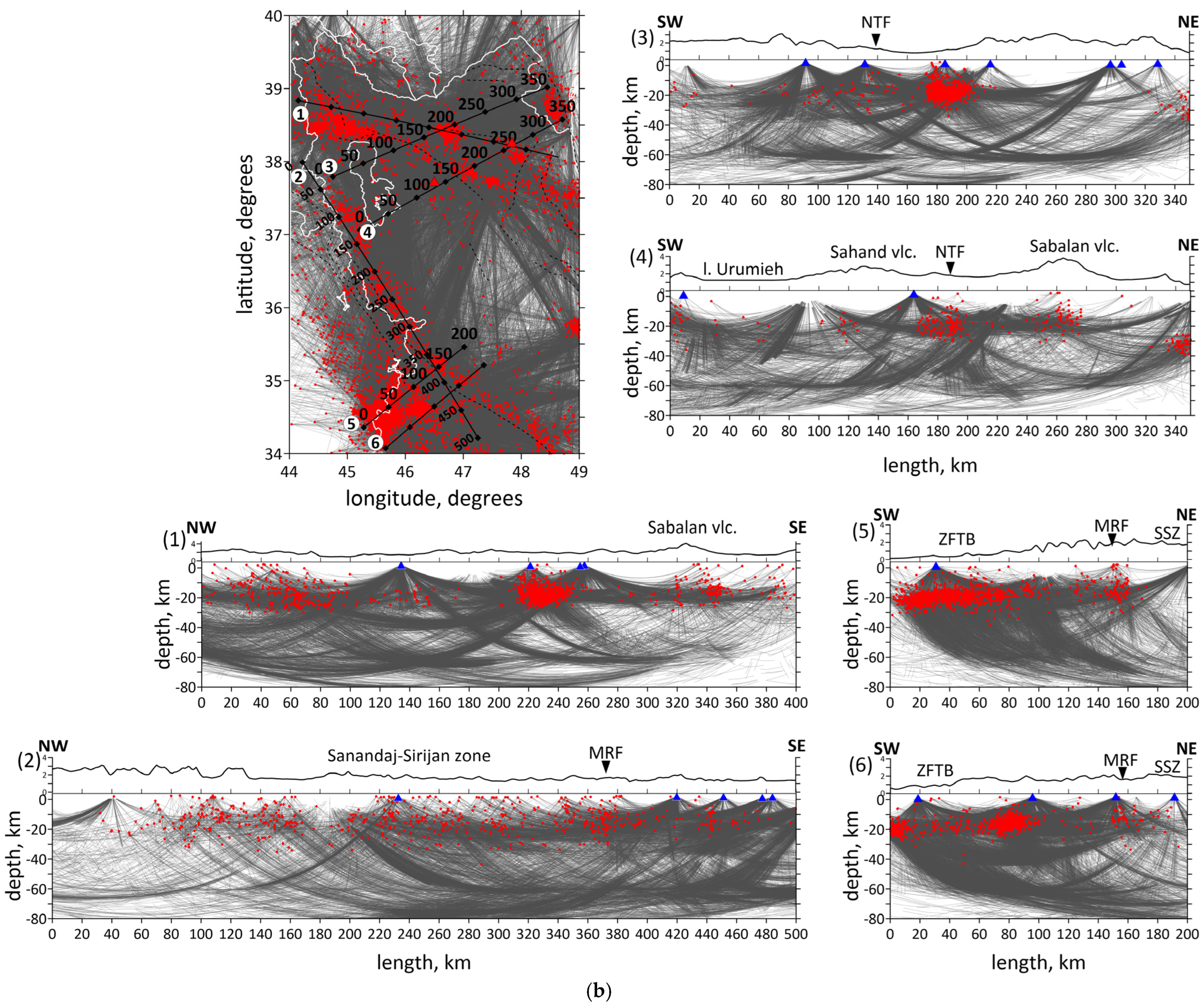
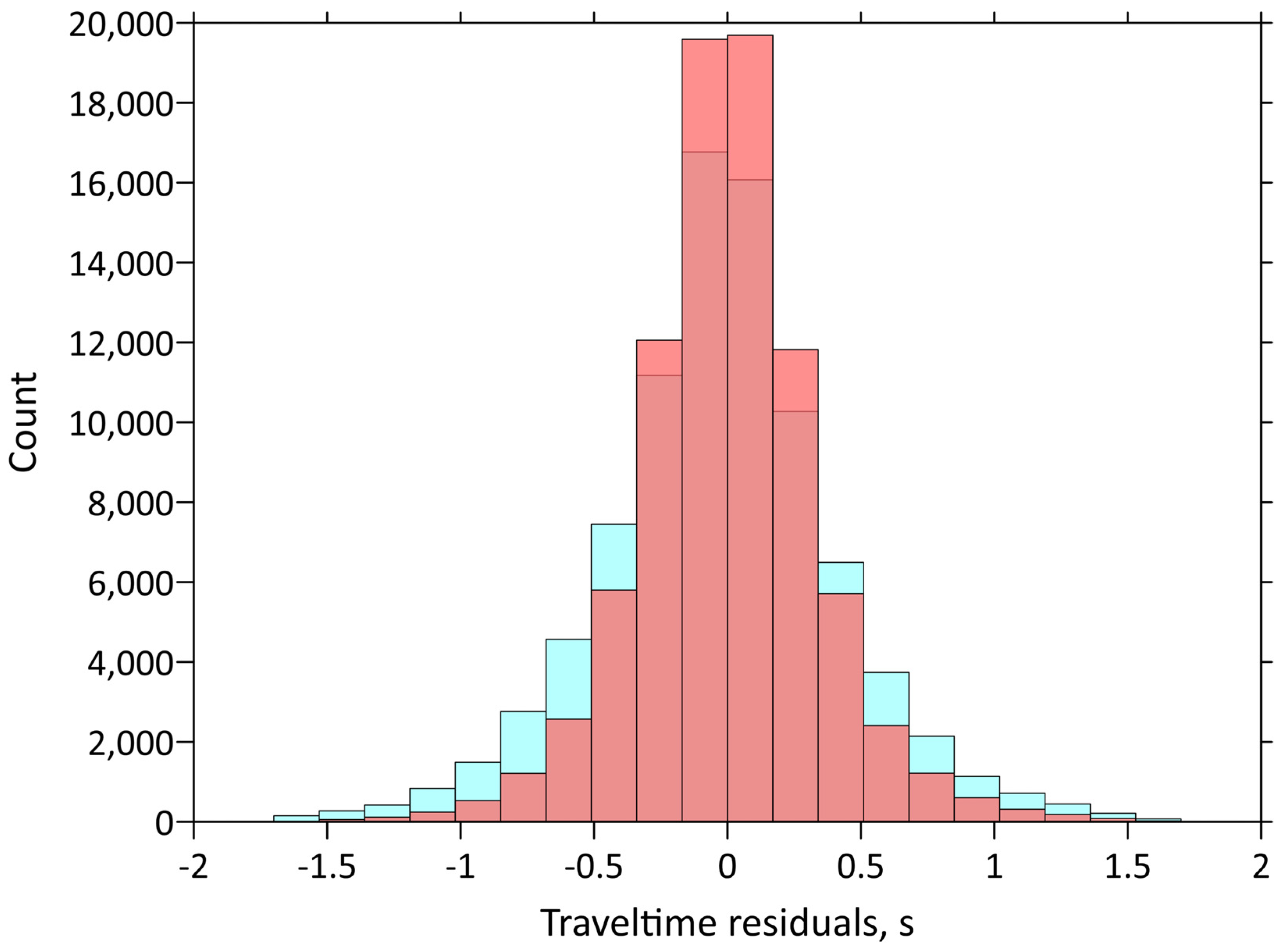

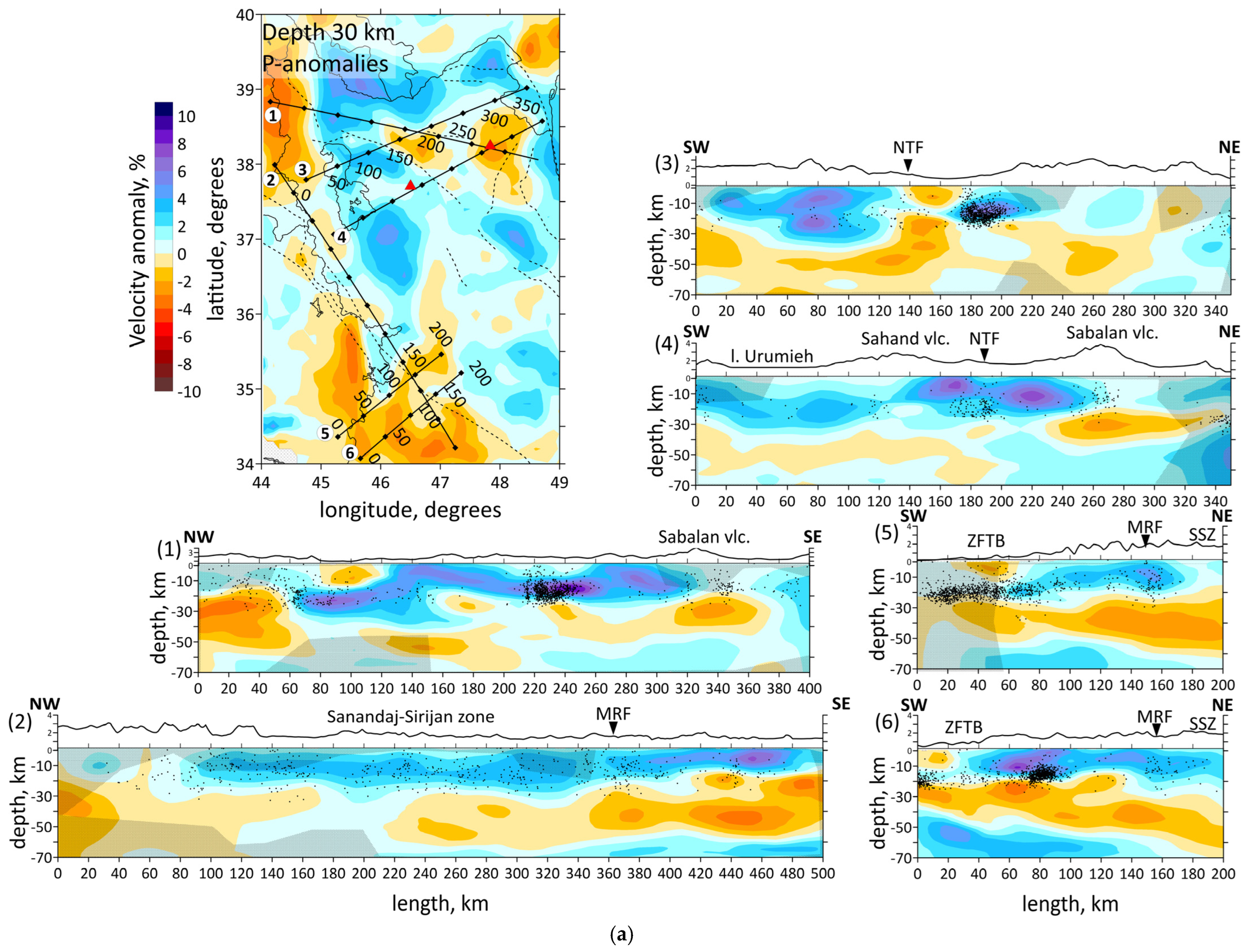

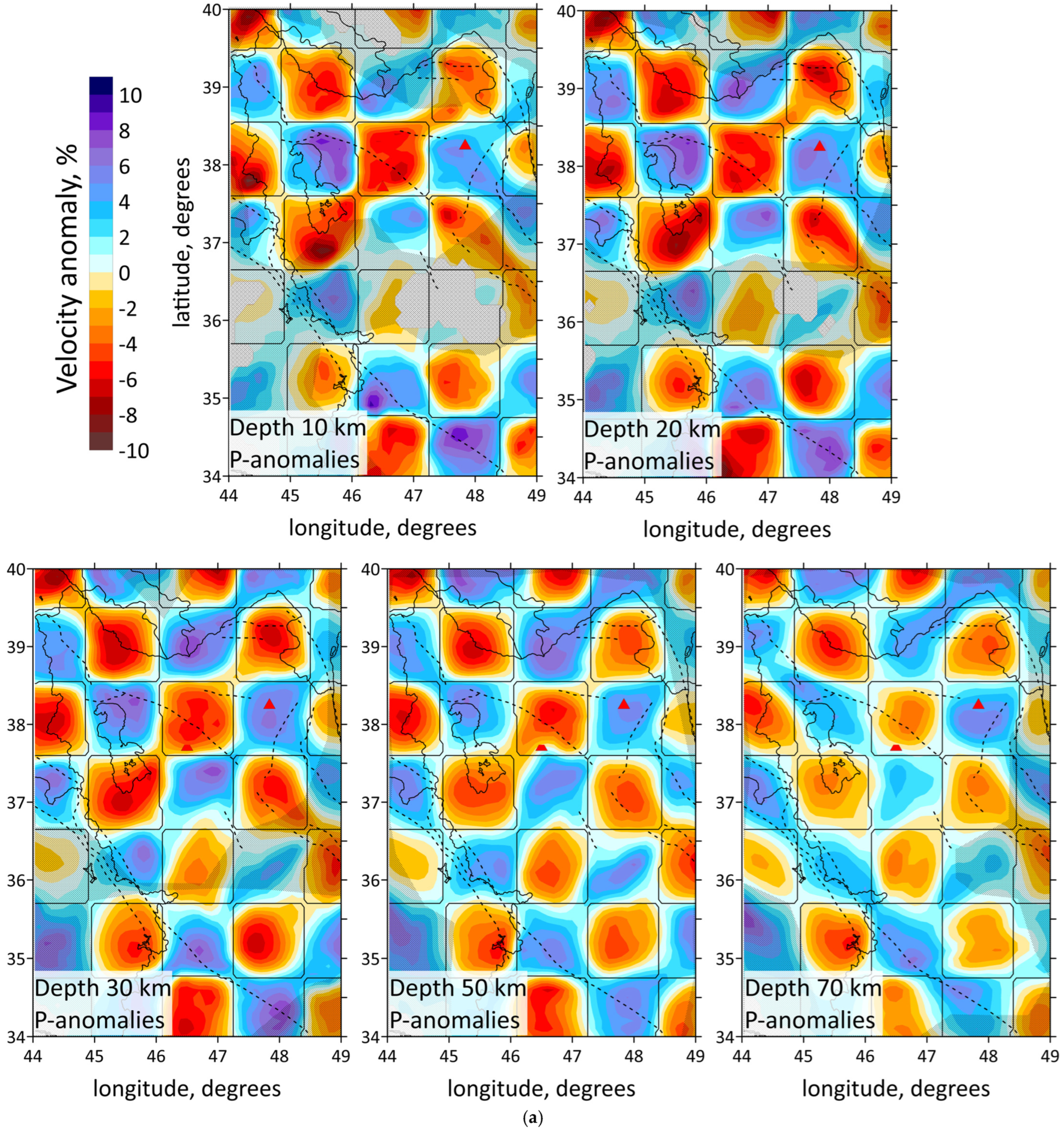
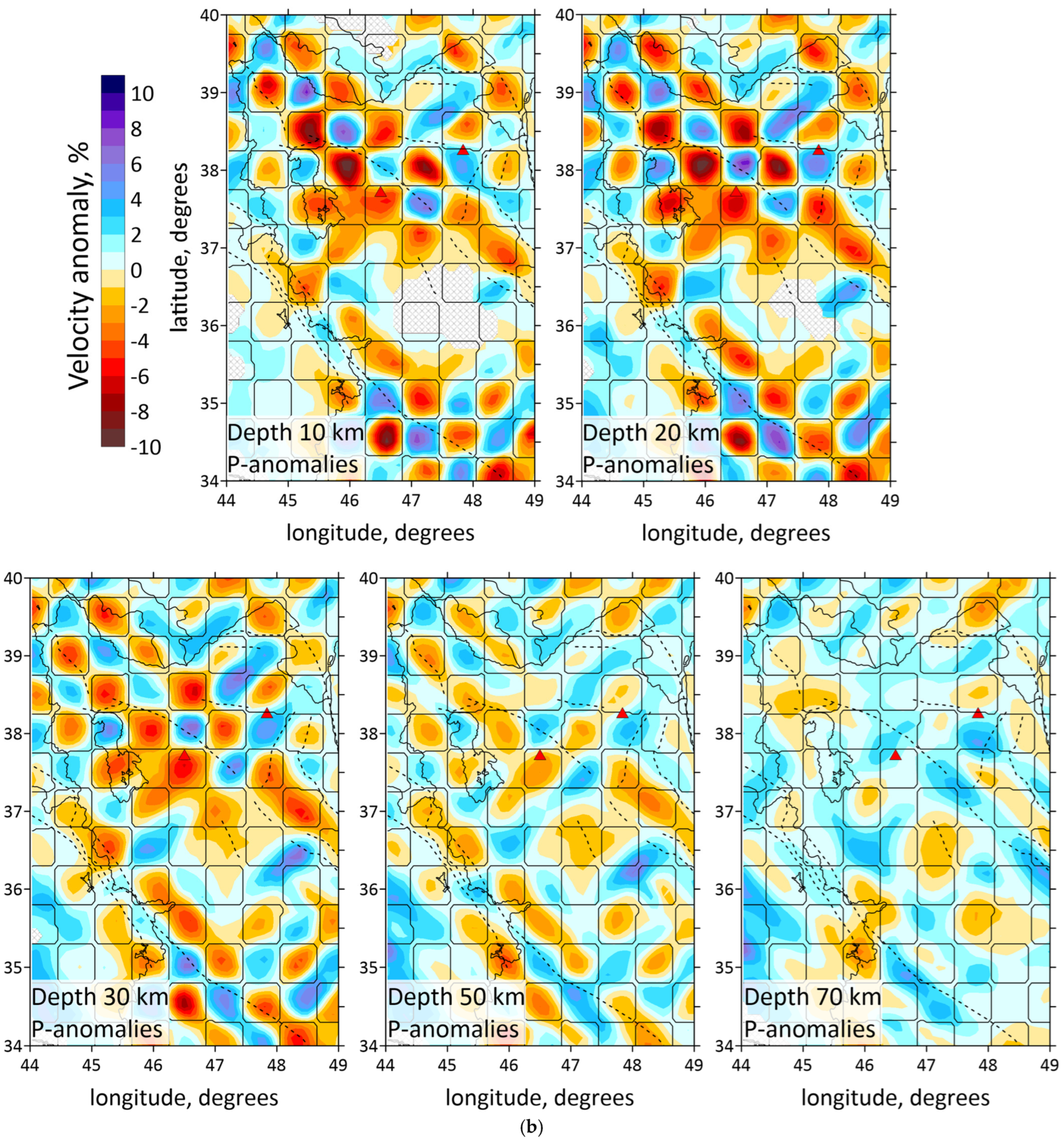

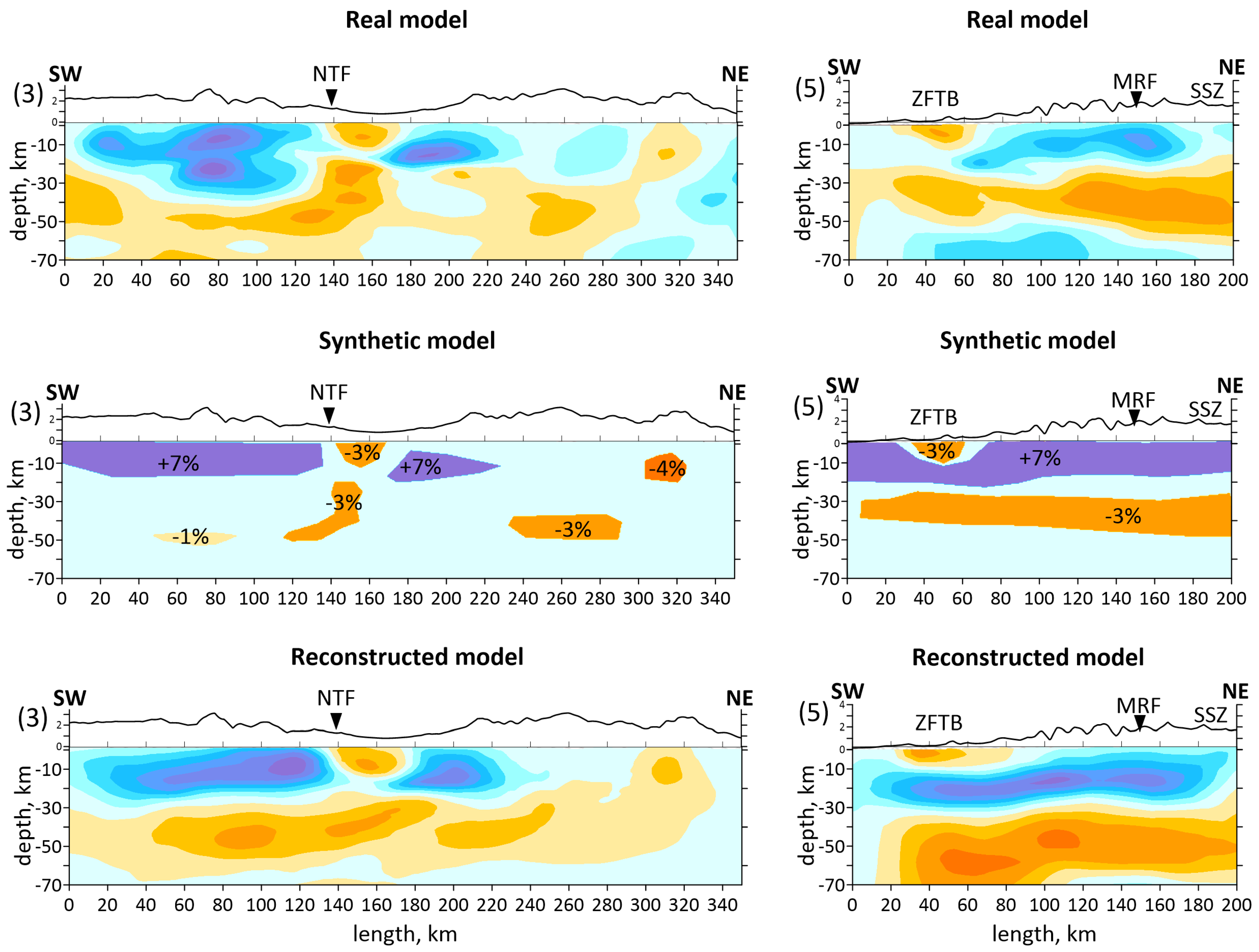

| Depth, km | Vp, km/s | Vs, km/s |
|---|---|---|
| −5 | 4.7 | 2.71 |
| 0 | 4.99 | 2.88 |
| 10 | 5.54 | 3.20 |
| 20 | 5.96 | 3.44 |
| 30 | 6.3 | 3.64 |
| 45 | 6.98 | 4.03 |
| 60 | 7.74 | 4.47 |
| 80 | 8.18 | 4.72 |
| 100 | 8.36 | 4.83 |
| Iteration | AMR of dtP, s | Variance Reduction, dtP, % | AMR of dtS, s | Variance Reduction, dtS, % |
|---|---|---|---|---|
| 1 | 0.35 | 0.0 | 0.38 | 0.0 |
| 2 | 0.28 | 17.8 | 0.28 | 24.2 |
| 3 | 0.278 | 21 | 0.27 | 28.8 |
| 4 | 0.272 | 22.6 | 0.26 | 30.9 |
| 5 | 0.269 | 23.4 | 0.25 | 32.5 |
Disclaimer/Publisher’s Note: The statements, opinions and data contained in all publications are solely those of the individual author(s) and contributor(s) and not of MDPI and/or the editor(s). MDPI and/or the editor(s) disclaim responsibility for any injury to people or property resulting from any ideas, methods, instructions or products referred to in the content. |
© 2025 by the authors. Licensee MDPI, Basel, Switzerland. This article is an open access article distributed under the terms and conditions of the Creative Commons Attribution (CC BY) license (https://creativecommons.org/licenses/by/4.0/).
Share and Cite
Talebi, A.; Medved, I.; Koulakov, I. Crustal Structure of Northwestern Iran on the Basis of Regional Seismic Tomography Data. Geosciences 2025, 15, 55. https://doi.org/10.3390/geosciences15020055
Talebi A, Medved I, Koulakov I. Crustal Structure of Northwestern Iran on the Basis of Regional Seismic Tomography Data. Geosciences. 2025; 15(2):55. https://doi.org/10.3390/geosciences15020055
Chicago/Turabian StyleTalebi, Amir, Irina Medved, and Ivan Koulakov. 2025. "Crustal Structure of Northwestern Iran on the Basis of Regional Seismic Tomography Data" Geosciences 15, no. 2: 55. https://doi.org/10.3390/geosciences15020055
APA StyleTalebi, A., Medved, I., & Koulakov, I. (2025). Crustal Structure of Northwestern Iran on the Basis of Regional Seismic Tomography Data. Geosciences, 15(2), 55. https://doi.org/10.3390/geosciences15020055






